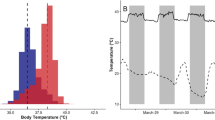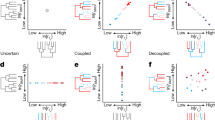Abstract
Although heterothermy (hibernation and torpor) is a common feature among mammals, there is debate over whether it is a derived or ancestral trait relative to endothermic homeothermy. Determination of the physiological characteristics of primitive mammals is central to understanding the evolution of endothermy. Moreover, evaluation of physiological mechanisms responsible for endothermic heat production [e.g. non-shivering thermogenesis (NST)] is key to understanding how early mammals responded to historical climate changes and colonised different geographical regions. Here we investigated the capacity for NST and heterothermy in the Hottentot golden mole, a basal eutherian mammal. NST was measured as the metabolic response to injections of noradrenalin and heterothermy by recording body temperature in free-ranging animals. We found that hibernation and torpor occurred and that the seasonal phenotypic adjustment of NST capacity was similar to that found in other placental mammals. Using phylogenetically independent contrasts, we compared measured values of NST with those obtained from the literature. This showed that all variation in NST was accounted for by differences in phylogeny and not zoogeography. These findings lend support to the observation that NST and heterothermy occur in the Afrotheria, the basal placental mammalian clade. Furthermore, this work suggests that heterothermy, rather than homeothermy is a plesiomorphic trait in mammals and supports the notion that NST mechanisms are phylogenetically ancient.







Similar content being viewed by others
References
Adkins RM, Gelke EL, Rowe D, Honeycutt RL (2001) Molecular phylogeny and divergence time estimates for major rodent groups: evidence from multiple genes. Mol Biol Evol 18:777–791
Augee ML, Gooden BA (1992) Monotreme hibernation—some afterthoughts. In: Augee ML (ed) Platypus and Echidnas. Royal Zoological Society of New South Wales, Sydney, pp 174–176
Barnes B (1989) Freeze avoidance in a mammal: body temperatures below 0°C in an Arctic hibernator. Science 244:1593–1595
Beck RMD, Bininda-Emonds ORP, Cardillo M, Liu FGR, Purvis A (2006) A higher-level MRP supertree of placental mammals. BMC Evol Biol 6:93
Bennett NC, Jarvis JUM, Davis KC (1988) Daily and seasonal temperatures in the burrows of African rodent moles. S Afr J Zool 23(3):189–195
Cannon B, Golozoubova V, Matthias A, Ohlsson KE, Jacobsson A, Nedergaard J (2000) Is there a life in the cold without UCP1? Uncoupling proteins and thermoregulatory thermogenesis. In: Heldmaier G, Klingenspor M (eds) Life in the cold. Springer, Berlin, pp 387–400
Cannon B, Nedergaard J (2004) Brown adipose tissue: function andphysiological significance. Physiol Rev 84:277–359
Chaline J, Graf J-D (1988) Phylogeny of the Arvicolidae (Rodentia): biochemical and paleontological evidence. J Mamm 69:22–33
Depocas F, Hart JS (1957) Use of the Pauling oxygen analyzer for measurement of oxygen consumption of animals in open-circuit systems and in a short-lag closed-circuit apparatus. J Appl Physiol 10:388–392
Dulloo AG, Samec S (2001) Uncoupling proteins: their roles in adaptive thermogenesis and substrate metabolism reconsidered. Br J Nut 86:123–139
Fielden LJ, Waggoner JP, Perrin MR, Hickmann GC (1990) Thermoregulation in the Namib Desert Golden Mole, Eremitalpa granti namibensis (Chrysochloridae). J Arid Environ 18:221–237
Garland T, Dickerman AW, Janis CM, Jones JA (1993) Phylogenetic analysis of covariance by computer simulation. Syst Biol 42:265–292
Garland T, Harvey PH, Ives AR (1992) Procedures for the analysis of comparative data using phylogenetically independent contrasts. Syst Biol 41:18–32
Geiser F, Baudinette RV (1990) The relationship between body mass and rate of rewarming from hibernation and daily torpor in mammals. J Exp Biol 151:349–359
Geiser F, Goodship N, Pavey CR (2002) Was basking important in the evolution of mammalian endothermy? Naturwissenschaften 89:412–414
Grigg GC (2004) An evolutionary framework for studies of hibernation and short term torpor. In: Barnes M, Carey HV (eds) Life in the cold: evolution, adaptation, mechanisms, and applications. Twelth International Hibernation Symposium. Biological Papers of the University of Alaska 27. University of Alaska, Fairbanks, pp 1–11
Grigg GC, Beard LA (2000) Hibernation by echidnas in mild climates: hints about the evolution of endothermy? In: Heldmaier G, Klingenspor M (eds) Life in the cold. Springer, Berlin, pp 5–20
Grigg GC, Beard LA, Augee ML (2004) The evolution of endothermy and its diversity in mammals and birds. Physiol Biochem Zool 77:982–997
Hayes JP, Garland T Jr (1995) The evolution of endothermy: testing the aerobic capacity model. Evolution 49:836–848
Heldmaier G (1971) Zitterfreie Wärmebildung und Körpergröβe bei Säugetieren. Z vergl Physiologie 73:222–248
Heldmaier G, Böckler H, Buchberger A, Lynch GR, Puchalski W, Steinlechner S, Wiesinger H (1985) Seasonal acclimation and thermogenesis. In: Gilles R (ed) Circulation, respiration, and metabolism. Springer, Heidelberg, pp 490–501
Heldmaier G, Boeckler H, Buchberger A, Klaus S, Puchalski W, Steinlechner S, Wiesinger H (1986) Seasonal variation of thermogenesis. In: Heller HC (ed) Living in the cold: physiological and biochemical adaptations. Elsevier, New York, pp 361–372
Haim A, Izhaki I (1993) The ecological significance of metabolic rate and nonshivering thermogenesis in rodents. J Therm Biol 18:71–81
Hickman GC (1979) A live trap and trapping technique for fossorial mammals. S Afr Zool 14:9–12
Hill RW (1972) Determination of oxygen consumption by use of the paramagnetic oxygen analyzer. J Appl Physiol 33(2):261–263
Holloway JC, Geiser F (2001) Seasonal changes in the thermoenergetics of the marsupial sugar glider, Petaurus breviceps. J Comp Physiol B 171:643–650
Jansky L (1973) Non-shivering thermogenesis and its thermoregulatory significance. Biol Rev 48:85–132
Jastroch M, Wuertz S, Kloas W, Klingenspor M (2005) Uncoupling protein 1 in fish uncovers an ancient evolutionary history of mammalian nonshivering thermogenesis. Physiol Genom 22:150–156
Klingenspor M, Helwig M, Fromme T, Brand MD, Kloas W, Taudien S, Platzer M, Jastroch M (2006) Uncoupling protein 1 is expressed in the brain of ectothermic vertebrates. Biochim Biophys Acta-Bioenerg 375–376
Körtner G, Geiser F (1998) Ecology of natural hibernation in the marsupial mountain pygmy-possum (Burramys parvus). Oecol 113:170–178
Kronfeld-Schor N, Haim A, Dayan T, Zisapel N, Heldmaier G (2000) Seasonal thermogenic acclimation of diurnally and nocturnally active desert spiny mice. Physiol Biochem Zool 73:37–44
Kuyper MA (1979) A biological study of the golden mole Amblysomus hottentotus. MSc Dissertation, University of Natal, Durban
Lovegrove BG (1989) The cost of burrowing by the social mole rats (Bathyergidae) Cryptomys damarensis and Heterocephalus glaber: the role of soil moisture. Physiol Zool 62:449–469
Lovegrove BG (2000) The zoogeography of mammalian basal metabolic rate. Am Nat 156:201–219
Lovegrove BG (2003) The influence of climate on the basal metabolic rate of small mammals: a slow-fast metabolic continuum. J Comp Physiol B 173:87–112
Lovegrove BG (2005) Seasonal thermoregulatory responses in mammals. J Comp Physiol B 175:231–247
Lovegrove BG, Génin F (2008) Torpor and hibernation in a basal placental mammal, the lesser hedgehog tenrec Echinops telfari. J Compar Physiol B (in press)
Lovegrove BG, Knight-Eloff A (1988) Soil and burrow temperatures, and the resource characteristics of the social mole-rat Cryptomys damarensis (Bathyergidae) in the Kalahari Desert. J Zool Lond 216:403–416
Lovegrove BG, Lawes MJ, Roxburgh L (1999) Confirmation of pleisiomorphic daily torpor in mammals: the round-eared elephant shrew Maroscelides proboscideus (Macroscelidea). J Comp Physiol B 169:453–460
Lovegrove BG, Raman J, Perrin MR (2001) Heterothermy in elephant shrews, Elephantulus spp. (Macroscelidea): daily torpor or hibernation? J Comp Physiol B 171:1–10
Lyman CP, Blinks DC (1959) The effect of temperature on the isolated hearts of closely related hibernators and non-hibernators. J Cell Comp Physiol 54:53–63
Lyman CP, Willis JS, Malan A, Wang LCH (1982) Hibernation and torpor in mammals and birds. Academic Press, New York
McKechnie AE, Lovegrove BG (2002) Avian facultative hypothermic responses. Condor 104:705–724
McNab BK (1978) The evolution of endothermy in the phylogeny of mammals. Am Nat 112:1–21
McNab BK (1992) The comparative energetics of rigid endothermy: the Arvicolidae. J Zool Lond 227:585–606
Malan A (1996) The origins of hibernation: a reappraisal. In: Geiser F, Hulbert AJ, Nicol SC (eds) Adaptations to the cold, tenth international hibernation symposium. University of New England Press, Armidale, pp 1–6
Mezhzherin VA (1964) Dehnel’s phenomenon and its possible explanation. Acta Theriol 8:95–114 In Russian with English summary
Michaux J, Catzeflis F (2000) The bushlike radiation of muroid rodents is exemplified by the molecular phylogeny of the LCAT nuclear gene. Mol Phylogenet Evol 17:280–293
Mzilikazi N, Lovegrove BG (2002) Exogenous passive heating during arousal in free-ranging rock elephant shrews, Elephantulus myurus. Oecol 133:307–314
Mzilikazi N, Lovegrove BG (2004) Daily torpor in free-ranging rock elephant shrews, Elephantulus myurus: a year-long study. Physiol Biochem Zool 77:285–296
Mzilikazi N, Lovegrove BG (2006) Noradrenalin induces thermogenesis in a phylogenetically ancient eutherian mammal, the rock elephant shrew, Elephantulus myurus. J Comp Physiol B 176:75–84
Nedergaard J, Cannon B (1986) Brown adipose-tissue thermogenesis in neonatal and cold-adapted animals. Biochem Soc Trans 14:233–236
Pagel M (1992) A method for the analysis of comparative data. J Theor Biol 156:431–442
Poppitt SD, Speakman JR, Racey PA (1994) Energetics of reproduction in the Lesser Hedgehog Tenrec, Echinops telfairi (Martin). Physiol Zool 67:976–994
Quinn GP, Keough MJ (2002) Experimental design and data analysis for biologists. Cambridge University Press, Cambridge
Rose RW, West AK, Ye JM, McCormack GH, Colquhoun EQ (1999) Nonshivering thermogenesis in a marsupial (The Tasmanian bettong Bettongia gaimardi) is not attributable to brown adipose tissue. Physiol Biochem Zool 72:699–704
Ruben JA (1995) The evolution of endothermy in mammals and birds: from physiology to fossils. Annu Rev Physiol 57:69–95
Scantlebury M, Oosthuizen MK, Speakman JR, Jackson CR, Bennett NC (2005) Seasonal energetics of the Hottentot golden mole at 1,500 m altitude. Physiol Behav 84:739–745
Scholl P (1974) Temperatureregulation beim madagassischen Igeltanrek Echinops telfairi (Martin 1838). J Comp Physiol 89:175–195
Skinner JD, Chimimba CT (2005) Mammals of the Southern African Sub-region. Cambridge University Press, Cambridge
Steppan SJ, Adkins RM, Anderson J (2004) Phylogeny and divergence-date estimates of rapid radiations in muroid rodents based on multiple nuclear genes. Syst Biol 53:533–553
Superina M, Boily P (2007) Hibernation and daily torpor in an armadillo, the pichi (Zaedyus pichiy). Comp Biochem Physiol A 148:893–898
Vleck D (1979) The energy cost of burrowing by the pocket gopher Thomomys bottae. Physiol Zool 52:122–125
Wang LCH (1989) Ecological, physiological and biochemical aspects of torpor in mammals and birds. In: Wang LCH (ed) Advances in comparative and environmental physiology, vol 4. Springer, Heidelberg, pp 361–401
Wildman DE, Uddin M, Opazo JC, Liu G, Lefort V, Guindon S, Gascuel O, Grossman LI, Romero R, Goodman M (2007) Genomics, biogeography, and the diversification of placental mammals. Proc Nat Acad Sci 104:14395–14400
Wunder BA, Gettinger RD (1996) Effects of body mass and temperature acclimation on the nonshivering thermogenic response of small mammals. In: Geiser F, Hulbert AJ, Nicol SC (eds) Adapatations to the cold: tenth international hibernation symposium. University of New England Press, Armidale, pp 1–404
Zar JH (1984) Biostatistical analysis. Prentice-Hall, New Jersey
Acknowledgments
We would like to thank Hermien Viljoen, Low de Vries, Johnny Wilson, Nicole Hagenah, Ingrid Mathissen and Laars Erik Andersen for assistance in the field. We thank the University of Pretoria for funding for fieldwork logistics. BGL provided the anaesthetics. The work was supported in part by postdoctoral fellowships of the University of Pretoria to MS and HL and by research grants from the National Research Foundation (RSA) to NCB and BGL. BGL was also supported by a core-rolling grant and incentive grants from the University of KwaZulu-Natal Research Office; NCB was additionally supported by funds from the University of Pretoria. The experiments reported in this study comply with the current laws of the country in which the experiments were performed.
Author information
Authors and Affiliations
Corresponding author
Additional information
Communicated by G. Heldmaier.
Electronic supplementary material
Below is the link to the electronic supplementary material.

Rights and permissions
About this article
Cite this article
Scantlebury, M., Lovegrove, B.G., Jackson, C.R. et al. Hibernation and non-shivering thermogenesis in the Hottentot golden mole (Amblysomus hottentottus longiceps). J Comp Physiol B 178, 887–897 (2008). https://doi.org/10.1007/s00360-008-0277-5
Received:
Revised:
Accepted:
Published:
Issue Date:
DOI: https://doi.org/10.1007/s00360-008-0277-5




